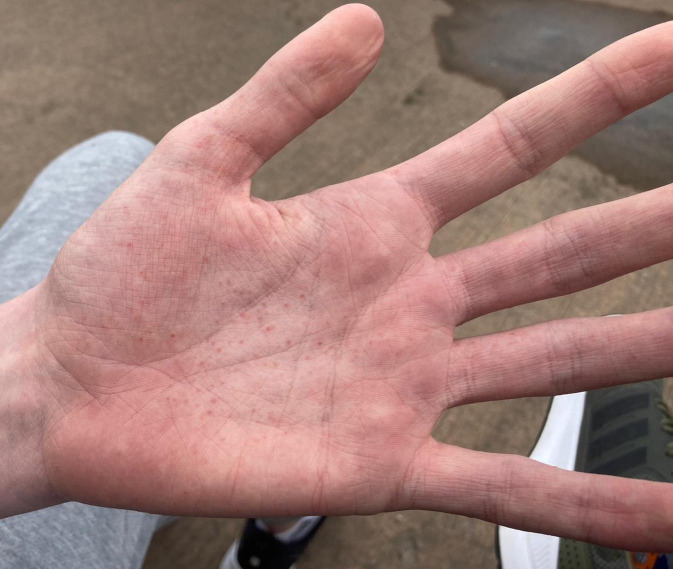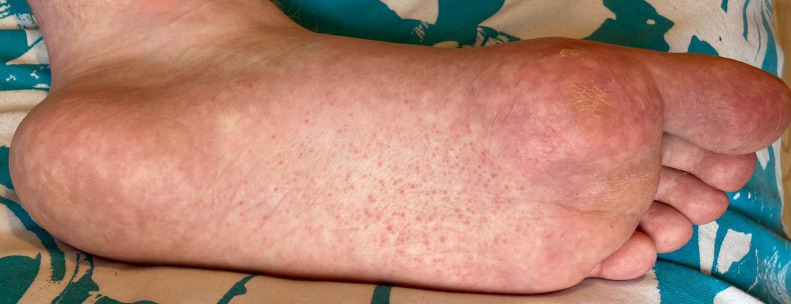Abstract
The COVID-19 pandemic has resulted in an incomparable disease burden worldwide. One of the main contributors stems from the multisystem inflammatory syndrome associated with SARS-CoV-2 infection. The numbers of those affected continue to rise with the increasing number of confirmed COVID-19 cases. However, we are yet to fully comprehend the risk factors, disease progression and prognosis for individuals affected. We describe a case of a previously healthy 17-year-old boy who tested positive for the SARS-CoV-2 virus. He presented with a 5-day history of mild influenza-like symptoms, however, quickly required ventilatory support in the intensive care unit. Two months postdischarge, he developed an isolated petechial rash on his palms and soles. His cutaneous presentation was in association with a mixed sensorimotor peripheral neuropathy, debilitating neuropathic pain and intermittent respiratory distress. We postulate that cutaneous manifestations post-COVID-19 could be indicatory of the newly identified multisystem inflammatory syndrome.
Keywords: COVID-19, respiratory medicine, peripheral nerve disease, global health, dermatology
Background
Since the beginning of the COVID-19 pandemic, skin manifestations have been associated with SARS-CoV-2, however, it is only now that they have become of increased interest. The most commonly documented have been recently classified into six main patterns, these include; urticarial, confluent erythematous−maculopapular−morbilliform, papulovesicular, chilblain-like acral, livedo reticularis–livedo racemosa-like and purpuric ‘vasculitic’.1 Although the underlying pathogenic mechanisms are unclear, complement activation, hyperactive immune response and microvascular injury have all been implicated.
COVID-19-induced cutaneous small-vessel vasculitis refers to a subgroup of vasculitis localised to the skin. The development of cutaneous small-vessel vasculitis can be drug induced or secondary to infection. Vascular damage secondary to heightened immune responses against viral antigen deposition is a recently postulated mechanism of small vessel vasculitis in conjunction with COVID-19 infection.2 The current hypothesis involves increased angiotensin II levels.3 ACE 2 is a receptor for the SARS-CoV-2 virus and expressed on various human tissues including alveolar pneumocytes, skin keratinocytes and vascular endothelium. The interaction between ACE 2 and the SARS-CoV-2 glycoprotein results in increased circulating angiotensin II with resultant vasoconstriction, endothelial dysfunction and thrombosis.3
Herein, we report a case of post-COVID-19 cutaneous small-vessel vasculitis isolated to the palmoplantar skin in association with SARS-CoV-2 multisystem inflammatory syndrome.
Case presentation
A 17-year-old boy with no underlying medical history presented to our dermatology department after developing an isolated asymptomatic palmoplantar rash. Two months prior, he had attended the emergency department with acute shortness of breath after a 5-day history of mild viral symptoms. He tested positive for SARS-CoV-2 and remained on ventilatory support in the intensive care unit (ICU) for a total of 12 days before being extubated. His post-COVID-19 recovery has been challenging with a new diagnosis of postviral mixed sensorimotor peripheral neuropathy, debilitating neuropathic pain and respiratory sequelae. His rash initially developed on the soles of his feet and slowly progressed to his palms. It developed 1 week after receiving a course of intravenous immunoglobulin over 5 days. Naturally, there was a clinical question whether this was a cutaneous side effect of intravenous immunoglobulin or potentially a drug rash secondary to his use of pregabalin, oxcarbazepine or oxycontin. On examination, he had an isolated purpuric rash involving his palms and soles bilaterally (figures 1 and 2), with sparing of his mucosal surfaces. His recent drugs were excluded as a causative factor, as no manifestations of an isolated purpuric palmoplantar rash had been described previously in the literature in association with his medications.
Figure 1.
Palmar petechial rash in association with SARS-CoV-2 multisystem inflammatory syndrome.
Figure 2.
Plantar petechial rash in association with SARS-CoV-2 multisystem inflammatory syndrome.
Investigations
Before his consultation, he had undergone investigations for his neurological deficit, with a subsequent diagnosis of a post-SARS-CoV-2 sensorimotor peripheral neuropathy established. Small fibre involvement was the causative factor for his ongoing neuropathic pain.
Our patient and his mother deferred a skin biopsy, as a means to establishing a definitive diagnosis. This decision was made on the basis of recent symptoms of post-traumatic stress, secondary to his unexpected ICU admission. It was decided that in this context, a watch and wait approach was more appropriate.
Outcome and follow-up
One month later, he was followed up with a teledermatology consultation. His palmoplantar rash had not progressed further and had begun to regress. His sensorimotor peripheral neuropathy and neuropathic pain, however, were still problematic but slowly improving. In the interim, he experienced a further episode of acute respiratory distress, requiring urgent assessment in the emergency department. His respiratory symptoms were deemed secondary to postviral inflammatory effects of COVID-19.
In the setting of a definitive diagnosis of sensorimotor peripheral neuropathy with small fibre involvement and post-COVID-19 respiratory symptoms, our patient’s cutaneous presentation was deemed to be secondary to SARS-CoV-2 induced small vessel vasculitis.
Discussion
The SARS-CoV-2, which has caused the COVID-19 pandemic, can result in a variety of contrasting clinical manifestations among infected individuals. Cutaneous manifestations associated with COVID-19 are similarly varied in appearance and do not typically reflect the course of the disease.
A purpuric vasculitic pattern is one of the classified COVID-19 cutaneous manifestations. Petechiae are small, subdermal haemorrhages, while purpura is a larger variant. Its presentation is less commonly described in association with COVID-19, compared with some of the other classified rashes and interestingly all cases that are described in the literature spare the palmoplantar skin. This is the first case of a vasculitic pattern isolated to the palmoplantar skin in association with confirmed SARS-CoV-2 RNA coronavirus.
Case reports of vasculitic rashes in association with COVID-19 are limited in the literature. One case of a petechial rash from Thailand was initially misdiagnosed as dengue fever, however, later the patient was found to be COVID-19 positive when they re-presented with respiratory distress.4 Other cases have described extensive erythematous macules, papules and petechiae isolated symmetrically to periflexural areas5 and extensive purpura isolated to flexural areas.6 Presentations of purpuric features within an extensive morbilliform rash have also been reported, however, also sparing the palmoplantar skin and mucosa.7 Interestingly, all these patients developed cutaneous features in the acute symptomatic stages of their illness and not in the postviral phase like in our case.
It has been suggested that the presentation of a purpuric or petechial rash in conjunction with a positive SARS-CoV-2 result is an indication of a milder form of COVID-19,8 however, this was not the case for our patient. Unlike case reports in the literature, our patient developed a vasculitic type rash in association with COVID-19 in the postviral phase and again unlike other case reports, had an acute severe life-threatening inflammatory response in conjunction with COVID-19. His palmoplantar petechial rash was deemed secondary to SARS-CoV-2 infection as there was no other reasonable cause, especially as he had post-COVID-19 sensorimotor peripheral neuropathy in conjunction with respiratory sequelae.
Although the diagnosis of petechiae was established clinically, the histopathology of other petechial rashes in association with COVID-19 has revealed a superficial perivascular lymphocytic infiltrate, extravasation of red cells and focal papillary oedema. Focal parakeratosis and dyskeratotic cells have also been visualised within the epidermis. Interestingly some have shown signs of pauci-inflammatory thrombogenic vasculopathy with deposition of complement (C5b–9 and C4d) in association with colocalisation of COVID-19 spike glycoproteins, while others show no signs of thrombotic vasculopathy.9 It is postulated that vascular damage in conjunction with SARS-CoV-2 infection is due to the immune response against viral antigen deposition.2
There is now a possibility that patients with COVID-19 might initially present with a skin rash in the asymptomatic phase of their illness and be misdiagnosed with another skin disease. It is imperative for clinicians to be wary of patients presenting with an acute rash and to protect themselves adequately with personal protective equipment. As our patient developed his rash in the postviral setting and in conjunction with respiratory sequelae and a mixed sensorimotor peripheral neuropathy as a consequence of COVID-19, we propose that cutaneous skin manifestations in the postviral setting could be an indication of impending multisystem inflammatory syndrome.
Patient’s perspective.
I basically have had to learn to walk again. I do two to two-and-a-half hours of physio every day, depending on how much energy I have. I wake up some days and I get really upset. I still don’t know why this happened to me or how I got it. It’s all because of COVID-19. This is proving to be a very, very long road to recovery.
Learning points.
This is the first case reported of an isolated vasculitic palmoplantar rash in association with COVID-19.
Cutaneous manifestations of COVID-19 19 can be classified into six main patterns, however, any new rash should warrant a high clinical suspicion for COVID-19.
COVID-19 skin manifestations may not equate to a mild form of disease.
Post-COVID-19 cutaneous manifestations could be a prognostic marker for the development of multisystemic inflammatory sequelae associated with SARS-CoV-2.
Footnotes
Contributors: Drafting of manuscript: LK. Conceptulisation and design: LK. Analysis: LK and AS. Revision of Manuscript: PEB and AS.
Funding: The authors have not declared a specific grant for this research from any funding agency in the public, commercial or not-for-profit sectors.
Competing interests: None declared.
Provenance and peer review: Not commissioned; externally peer reviewed.
Ethics statements
Patient consent for publication
Obtained.
References
- 1.Marzano AV, Cassano N, Genovese G, et al. Cutaneous manifestations in patients with COVID-19: a preliminary review of an emerging issue. Br J Dermatol 2020;183:431–42. 10.1111/bjd.19264 [DOI] [PMC free article] [PubMed] [Google Scholar]
- 2.Mayor-Ibarguren A, Feito-Rodriguez M, Quintana Castanedo L, Castanedo LQ, et al. Cutaneous small vessel vasculitis secondary to COVID-19 infection: a case report. J Eur Acad Dermatol Venereol 2020;34:541–2. 10.1111/jdv.16670 [DOI] [PMC free article] [PubMed] [Google Scholar]
- 3.Vaduganathan M, Vardeny O, Michel T, et al. Renin-angiotensin-aldosterone system inhibitors in patients with Covid-19. N Engl J Med 2020;382:1653–9. 10.1056/NEJMsr2005760 [DOI] [PMC free article] [PubMed] [Google Scholar]
- 4.Joob B, Wiwanitkit V. COVID-19 can present with a rash and be mistaken for dengue. J Am Acad Dermatol 2020;82:177. 10.1016/j.jaad.2020.03.036 [DOI] [PMC free article] [PubMed] [Google Scholar]
- 5.Diaz-Guimaraens B, Dominguez-Santas M, Suarez-Valle A, et al. Petechial skin rash associated with severe acute respiratory syndrome coronavirus 2 infection. JAMA Dermatol 2020;156:820–2. 10.1001/jamadermatol.2020.1741 [DOI] [PubMed] [Google Scholar]
- 6.Jimenez-Cauhe J, Ortega-Quijano D, Prieto-Barrios M, et al. Reply to "COVID-19 can present with a rash and be mistaken for dengue": Petechial rash in a patient with COVID-19 infection. J Am Acad Dermatol 2020;83:e141–2. 10.1016/j.jaad.2020.04.016 [DOI] [PMC free article] [PubMed] [Google Scholar]
- 7.Avellana Moreno R, Estela Villa LM, Avellana Moreno V, Villa E, Moreno A, et al. Cutaneous manifestation of COVID-19 in images: a case report. J Eur Acad Dermatol Venereol 2020;34:307–9. 10.1111/jdv.16531 [DOI] [PMC free article] [PubMed] [Google Scholar]
- 8.Wollina U, Karadağ AS, Rowland-Payne C, et al. Cutaneous signs in COVID-19 patients: a review. Dermatol Ther 2020;33:e13549. 10.1111/dth.13549 [DOI] [PMC free article] [PubMed] [Google Scholar]
- 9.Magro C, Mulvey JJ, Berlin D, et al. Complement associated microvascular injury and thrombosis in the pathogenesis of severe COVID-19 infection: a report of five cases. Transl Res 2020;220:1–13. 10.1016/j.trsl.2020.04.007 [DOI] [PMC free article] [PubMed] [Google Scholar]




